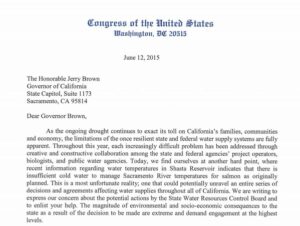News Line – November 20, 2014
Read the latest news about issues affecting agriculture and farm water in California.
|
No Coalition Responses Today
|
|
From: Staff, Los Angeles Times
California made extraordinary progress on water policy in this severe drought year, largely under the guiding hand of Gov. Jerry Brown. The governor’s master stroke was to initiate the conversation and then back away, allowing various interests – agribusiness, urban areas, environmentalists, people who favored building tunnels to move water from north to south, people who vigorously opposed them – to fight it out.
|
|
From: Staff, Sacramento BeeSen. Dianne Feinstein and House Republicans have been secretly negotiating drought relief legislation that could severely alter California water policy. She should know better.Any legislation on the topic of water would have far-reaching implications, and ought to receive a full public airing before a congressional vote.
|
|
From: Tom Philpott, MotherJones.comSen. Dianne Feinstein (D-Calif.) is negotiating a behind-closed-doors deal with Republican lawmakers to pass a bill that would ostensibly address California’s drought-an effort that has uncorked a flood of criticism from environmental circles.Feinstein’s quiet push for a compromise drought bill that’s palatable to Big Ag-aligned House Republicans has been in the works for six months, Kate Poole, a senior attorney with the Natural Resources Defense Council, told me. And it has accelerated recently, as the Senator hopes to pass it by year end, during the “lame duck” period of the outgoing Democratic-controlled Senate.
|
|
From: J. Lund, A. Taghavi, M. Hall, A. Saracino, & L. Winternitz, UC Davis Watershed Sciences & Bechtel FoundationCalifornia’s approval of a $7.5 billion water bond has bolstered prospects for expanding reservoirs and groundwater storage, but the drought-prone state can effectively use no more than a 15 percent increase in surface water storage capacity because of lack of water to fill it, according to a new analysis released Nov. 20.The report by water engineers and scientists with the University of California, Davis, The Nature Conservancy and three prominent water consultants, said California could potentially use up to 6 million acre-feet in combined additional surface and groundwater storage – about a third more capacity than Shasta Reservoir. Exceeding this expansion runs into limits of available precipitation and the ability to transport water.
|
|
From: J.N. Sbranti, Modesto Bee
A briefing of the Stanislaus County Water Advisory Committee on the state’s proposals to reduce river diversions for agriculture quickly turned into a pointed discussion about Oakdale Irrigation District’s determination to pump groundwater for its farmers while selling surface water to agencies outside the region.
|
|
From: H. Miller & R. Cornett, Forbes“Sustainable” has become a buzzword that is applicable not only to agriculture and energy production but to sectors as far afield as the building and textile industries. Some universities offer courses or even degrees in “sustainability.” Many large companies tout the concept and boast a sustainability department, and the United Nations has hundreds of projects concerned with sustainability throughout its many agencies and programs.But as with many vague, feel-good concepts-“natural” and “locavorism” come to mind-it contains more than a little sophistry. For example, sustainability in agriculture is often linked to organic food production, whose advocates tout it as a “sustainable” way to feed the planet’s expanding population.
|
